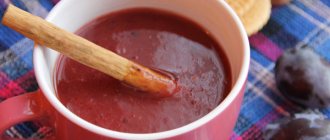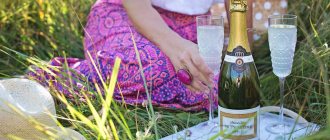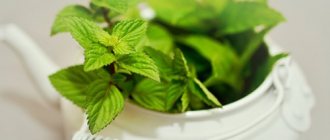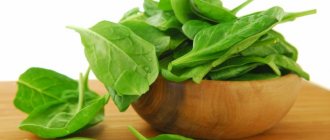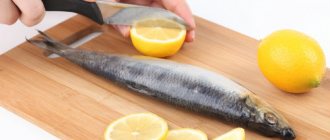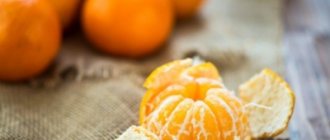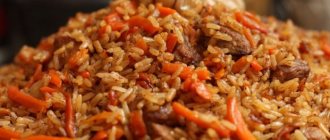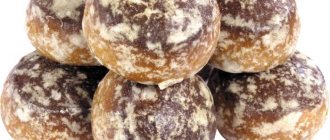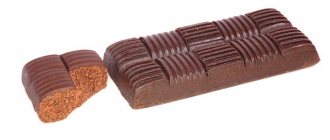How mustard plasters work
Mustard plasters are a medicinal product that has a local irritant and analgesic effect on the skin. This effect is due to the presence of essential oils in mustard seeds. Upon contact with the skin, cell irritation occurs, which causes increased blood circulation. In addition, mustard mass contains the enzyme myrosin, which, when exposed to warm water, has a warming and antiseptic effect.
Mustard plasters are products with an irritant, anti-inflammatory effect, effective for the treatment of colds, sprains and muscle pain
The pharmaceutical industry produces mustard plasters in two versions:
- Sheets of thick paper soaked in mustard solution.
- Double-layer paper bags containing dry mustard inside.
Mustard plasters effect
Widely known pharmaceutical mustard plasters based on natural mustard seed powder are an effective remedy for the treatment of cold symptoms such as runny nose and cough. This therapeutic effect is due to the essential oils contained in mustard powder. When they come into contact with the skin, a local increase in blood circulation occurs, which has a beneficial effect on the course of a cold.
Pharmacy mustard plasters are produced in two-layer paper bags, as well as in the form of pieces of thick paper, which is soaked in mustard solution. Some medical experts compare the effect of pharmaceutical mustard plasters with a type of physiotherapeutic procedures. This simple and effective remedy is used for inflammatory diseases of the lung tissue, acute respiratory viral infection, bronchitis, muscle and tendon strains, as well as radiculitis and osteochondrosis.
In addition, natural mustard powder contains a specific enzyme, myrosin, which can be activated under the influence of warm water and have a pronounced antiseptic and antimicrobial effect. This biologically active component easily penetrates through skin pores, causing a mild local irritant effect.
Indications for use
Mustard products are one of the inexpensive and effective means of physiotherapy. They are recommended for use when:
- pneumonia;
- acute respiratory infections (acute respiratory diseases);
- cough;
- runny nose;
- bronchitis;
- acute tracheitis (dry cough with sputum production);
- neuralgia (piercing pain in the area of the damaged nerve);
- headaches associated with high blood pressure;
- radiculitis;
- osteochondrosis (a disease of the spine accompanied by pain in the back and neck).
How to use mustard plasters correctly
During lactation there is no ban on the use of mustard products. However, they should be placed only on certain places on the skin and very carefully. Before using mustard plasters, a nursing mother should consult her doctor.
Rules for the use of mustard plasters
Doctors warn that nursing mothers should place mustard plasters on the chest area in such a way that they do not come into contact with the mammary glands. The fact is that the essential oil present in mustard seeds penetrates the skin, and some of it can pass into breast milk. There is a risk of the baby developing allergic reactions to this component, so you need to carefully monitor the position of the mustard plasters in the chest area so as not to subsequently harm the baby.
When a cough or runny nose occurs, doctors advise applying mustard plasters:
- between and under the shoulder blades;
- on calves and feet;
- on the palm (effective for dry cough).
The feet are responsible for the nasopharynx, so mustard plasters should be placed on them at the first sign of a cold, and warm woolen socks should be put on top.
Nursing mothers are not prohibited from having mustard plasters placed, but care must be taken that they do not come into contact with the mammary glands.
For bronchitis and pneumonia, mustard plasters should be placed on the side and front of the chest, as well as on the upper back.
For the procedure you will need:
- warm water;
- a small container so that it is convenient to completely immerse the mustard leaf;
- clean napkins;
- terry towel.
The procedure itself is quite simple:
- If mustard sachets are used, shake them to evenly distribute the powder.
- Mustard plaster is dipped in warm water for 3-4 seconds and applied to the selected area of the body. If there is increased sensitivity, it is recommended to place them through a thin layer of gauze or bandage.
- Cover the product with a terry towel on top and leave it on the body for 5–10 minutes.
- The mustard plaster is removed and the skin is wiped with a damp cloth.
- If after the procedure there are red marks on the skin, you can smear these areas with body cream.
After this event, you need to wrap yourself in a warm blanket and lie in bed for 30–40 minutes.
Please note that mustard plasters are not reused. Once removed from the skin, they are thrown away.
Mustard plasters during lactation
Is it possible to put mustard plasters on a nursing mother? During lactation, you have to give up many medications, as they worsen the quality of milk and can negatively affect the baby. For a nursing mother, the solution to problems can be folk remedies that are harmless to the body and will not affect the baby in any way.
Tablet medications are not suitable as they will affect the baby through breast milk.
In order to know whether it is possible to put mustard plasters on a nursing mother, you need to know how they work and what they are.
How mustard plasters work
Mustard plasters are sheets of paper coated with mustard powder, or bags, impenetrable on one side and porous on the other, in which case the mustard is inside the bag.
Mustard plasters have an irritating and warming effect, accelerating blood flow and facilitating sputum discharge. Essential oils penetrate deep into tissues, relieving inflammation and stimulating the production of immune cells.
Mustard plasters are used as a therapeutic agent for the following diseases:
- bronchitis;
- pneumonia;
- respiratory viral infections;
- muscle pain;
- exacerbation of osteochondrosis.
Mustard plasters do not have a harmful effect on the mother's body and do not affect breast milk.
You can make mustard plasters yourself: for this you will need wax paper, starch paste, and mustard seed powder. If desired, you can add other plants containing essential oils: cloves, thyme or anise.
Sheets of paper are cut into squares, soaked in paste on one side, then dipped with the sticky side into mustard powder.
Mustard plasters need to dry for 1-2 days, after which they can be used.
How to use during lactation
Mustard plasters are applied to the chest and back, as well as to the feet and calf muscles. During lactation, mustard plasters should be placed in such a way that they do not affect the mammary gland.
It is recommended not to touch the chest area; place the patches on the back and side of the chest.
You can also apply mustard plaster in the area under the collarbones - this way the mammary gland will not be covered with mustard plaster.
To install mustard plasters you will need mustard plasters and warm water, the procedure is performed as follows:
- Shake the bag so that the mustard is distributed evenly in the container.
- The mustard plaster is placed in warm water for a few seconds and applied with the porous side to the skin in the area of application.
- After installing all the packages, cover yourself with a blanket and lie down for 5-15 minutes.
- After time, the mustard plaster is removed from the skin, the remaining mustard oil is washed off, and the skin is wiped dry with a towel.
After the procedure, you should rest for 30-40 minutes and only then get out of bed.
When placing mustard plasters on the feet, wool socks are put on top. In case of swelling of the nasopharynx, mustard plasters are installed on the leg muscles. The first procedure must be performed with caution, carefully monitoring the condition of the skin: if pain occurs, excessive itching, the skin turns red and begins to peel, therapy should be abandoned in favor of more gentle means.
The benefits and harms of mustard plasters
Mustard plasters are used during lactation, as they contain only natural plant components and will not harm the baby.
Mustard oil has a pronounced anti-inflammatory effect, promotes rapid mucus removal, stimulates the immune system, and has minimal side effects.
Another beneficial effect of mustard plasters is the antitoxic effect: due to increased blood supply and sweating, waste products of pathogenic microorganisms are removed from the blood.
However, there are also negative aspects: mustard irritates the skin and is not suitable for women with dry, delicate skin, as well as for persons with disorders of the sebaceous and sweat glands.
It is not recommended to place mustard plasters on the area of the heart and large vessels.
Also, mustard oil can slightly affect the taste of breast milk, giving an unpleasant taste. If the child begins to refuse breastfeeding, becomes more nervous or whiny, it is worth looking for a replacement for mustard plasters.
Complications and contraindications
Like any medicinal product, mustard plasters have contraindications for use. They are not recommended for use when:
- body temperature above 37 o C;
- violation of the integrity of the skin (wounds, scratches, burns);
- individual intolerance to components;
- the presence of moles, warts and other neoplasms;
- pulmonary hemorrhage;
- lack of sensitivity;
- bronchial asthma.
Complications can be caused by non-compliance with the rules for using mustard products:
- overexposure to mustard plasters can cause severe redness of the skin (burn);
- their frequent use leads to skin pigmentation;
- an allergic reaction may occur in the form of a rash with itching (occurs due to individual intolerance to the components).
Video: Mustard plasters are effective cough remedies
How to make mustard plasters with your own hands
You don’t have to buy mustard plasters - you can make them yourself. To do this, you need to mix dry mustard with wheat flour in a 1:1 ratio. Add a little warm water to the mass and stir until a homogeneous paste is obtained, which is laid out between two layers of damp cloth. Mustard plaster should be used immediately after production.
Homemade mustard products are much stronger than factory ones, so you need to carefully monitor your sensations during the procedure to avoid burns.
How to replace the product
If a nursing mother for some reason cannot make mustard applications, you can use alternative treatment methods.
A decoction of plantain, licorice root and thyme is used as a compress on the chest area for inflammatory processes in the respiratory tract. It acts gently on the body without causing irritation. To prepare it, you need to pour 1 tbsp of boiling water over 1 liter. l. dry herbs, and then cook it over low heat for 5–7 minutes. Strain the mixture, moisten a cloth in the resulting broth and apply a compress to the desired area of skin. Cover the top with cellophane and a terry towel. Keep on the body for 10 minutes.
The pharmacy chain offers ready-made syrups based on plantain, which can be taken during lactation.
Honey has long been used for all types of colds. Thanks to the beneficial substances it contains, it effectively fights the symptoms of the disease. Here are some effective recipes:
- Dissolve 1 tsp in a glass of warm milk. honey and add ½ tsp. butter. Drink in small sips.
- Dilute apple cider vinegar in warm water in a ratio of 1:3, add 1 tbsp to the mixture. l. honey. Stir well and use as a compress on the chest. Keep for about 15 minutes.
It should be borne in mind that honey is a strong allergen, so it can only be used if there is no negative reaction to bee products.
Photo gallery: alternative replacements for mustard plasters
Honey is a natural beekeeping product that is widely used in folk medicine to treat colds. Plantain has an expectorant, anti-inflammatory effect and is good for coughs. Licorice root helps thin mucus, facilitates expectoration and protects the throat from irritation.
Mustard applications during lactation will help speed up the healing process and will not harm the baby. In any case, a woman needs to seek help from a specialist to prevent serious complications.
Colds are uninvited visitors that appear during seasonal peaks or in the form of isolated cases “out of schedule.” More often, their target is a weakened body that is unable to effectively fight back the disease. Breastfeeding women fall into this category. Life resources have not yet been restored after pregnancy and childbirth, and new chores require physical exertion against the backdrop of chronic lack of sleep and worries about the baby.
Colds include viral infections that affect the upper respiratory tract. The body responds to their appearance with general reactions - fever, weakness, headache, loss of appetite. The struggle between pathogenic agents and the body takes place on the mucous membranes of the nose, pharynx, and larynx. The local reaction is manifested by a runny nose and nasal congestion, sore and sore throat, and cough.
When the first signs of illness are detected in a nursing mother, questions arise about the advisability of drug treatment and continued breastfeeding. The fear of infecting the baby with a virus and at the same time the reluctance to interrupt natural feeding is a dilemma that requires a competent solution.
Mustard when feeding a newborn
The list of prohibited foods when breastfeeding is quite long. Nutrition for breastfeeding women has strict restrictions, since any food eaten by the mother directly affects the well-being and condition of the baby - some are good, others are bad. So, which foods are prohibited and which are allowed when breastfeeding?
What breastfeeding foods should absolutely not contain is alcohol. Calming herself with the thought that one glass of red wine will not affect the child in any way, the mother must be aware of the fact that
Source
Newborn stool during breastfeeding
What does it mean. This is what original stool looks like; it consists of substances that the baby swallowed along with the amniotic fluid in the mother’s womb. Its appearance means that the newborn’s intestines are working normally and he is receiving plenty of mother’s colostrum.
What we see. The color of the stool ranges from yellow to mustard or brown, the smell is mild, sour milk. The consistency is reminiscent of liquid semolina porridge. There are inclusions of white grains, small impurities of mucus or greenery. The child is gaining weight well.
What does it mean. In front of you is the normal stool of a breastfed baby. Until 6 weeks, most breastfeeding babies have bowel movements from 4 to 12 times a day. After 1.5-2 months, stool frequency decreases (from 2-4 times a day to once every 2-5 days)
What we see. The contents of the diaper are light brown or dark brown in color, sometimes interspersed with greenery; the stool is mushy or thick, but not hard, with a strong unpleasant odor. The child is gaining weight well.
What does it mean. Normal stool of a baby who is on artificial or mixed feeding, or a baby who has begun to receive complementary foods.
What we see. The stool is green, mushy and
Source
Mayonnaise for breastfeeding
Breastfeeding mothers simply must eat healthy and balanced. Their menu should not contain harmful dishes and products. It's no secret that store-bought mayonnaise is one of those. What should lactating women know about this popular sauce? How do nutritionists and breastfeeding specialists evaluate its presence on a nursing mother’s menu?
Pediatricians do not welcome its presence on the menu. The high fat content of mayonnaise creates a load on the digestive organs, the risk of allergic reactions and tummy problems in a newborn.
French sauce undoubtedly improves the taste of many dishes. But its calorie content is about 700 kilocalories per 100 grams. The product contains vegetable oil, mustard, vinegar, eggs, and spices. Only the first component does not cause problems for nursing mothers. Eggs are an allergenic product.
Spices often cause skin rashes. Vinegar can cause digestive problems in a baby. Therefore, breastfeeding experts do not advise lactating mothers to use this sauce, even if it is homemade.
And there is nothing to say about store-bought ones - they are very dangerous when feeding a newborn.
Source
Is it possible to have mustard while breastfeeding?
Mustard is a spicy table seasoning that is served with meat and fish, and is also used to prepare sauces and dressings for vegetable dishes. If you consume mustard in small portions, it will not cause harm to a person’s health, but, nevertheless, there are restrictions on its intake, and they apply to pregnant and lactating women.
The most unsafe ingredient in mustard is vinegar, which contains a certain percentage of acetic acid. It causes irritation to the digestive tract and can cause stomach and intestinal diseases in a newborn.
Depending on the recipe, mustard may also contain a variety of spices - cinnamon, cloves, pepper. If a nursing woman eats mustard, the taste of these foods may affect the quality and taste of breast milk. The baby may refuse to latch on to the breast in this case.
Another reason why it is advisable to exclude mustard from a nursing woman’s diet is that this industrially produced table seasoning contains large quantities of preservatives, flavorings, and dyes.
The baby's gastrointestinal tract is still poorly developed, and food additives have a detrimental effect on it and the entire child's body as a whole. They can cause allergic reactions on the child's skin. These include redness, rash, itching, and peeling.
And the processing and removal of these substances from the small body puts a large burden on the baby’s liver and kidneys.
Doctors also say that food additives, once in the body of a nursing woman, slow down the process of milk production, there is less milk, and its quality deteriorates.
If a mother who is breastfeeding still intends to eat
Source
Can a nursing mother have mustard: harm or benefit?
Mustard is a spicy table seasoning that doctors do not recommend using during breastfeeding. At the very least, you should abstain from such a product in the first 6-8 months after childbirth. Every nursing mother knows about the restrictions on the menu, because food components pass into breast milk, and then into the baby’s body.
The baby’s body is just adapting to new conditions and often reacts negatively to overeating and some foods in the mother’s diet. A negative result from poor nutrition and consumption of mustard during breastfeeding can be poisoning, severe colic and food allergies in the child.
Undoubtedly, mustard also performs useful functions. The product contains vitamins A, E, B and D.
By the way, vitamin D is a very important element for infants, because in the first months of life, children face the problem of a lack of this vitamin.
It ensures normal bone growth and is found in sunlight and some foods. With a lack of vitamin D in children, the bone skeleton and immunity weaken, rickets and caries develop!
The product also contains useful minerals such as calcium and sodium, zinc and potassium, magnesium and other macro- and microelements. Mustard seeds contain protein, fats and essential oils necessary for the mother’s rapid recovery after childbirth and the full growth and development of the baby.
Despite the positive effect, the product should not be consumed in large quantities. The seasoning has strong burning properties, which can lead to irritation and burns of the digestive organs.
In addition to useful elements, mustard also contains vinegar with a certain percentage of acid. Acetic acid causes digestive irritation and can lead to serious
Source
what can you eat while feeding your baby
Proper nutrition for a nursing mother contains many subtleties and nuances. After all, the nutrition, health and full development of her baby directly depend on this. What can and should a woman eat while breastfeeding? What does a nursing mother's menu consist of and how to quickly lose weight after childbirth if you are breastfeeding?
In many maternity hospitals to this day, Soviet principles of feeding new mothers are preserved. Not only is there no variety in the nutrition of a nursing mother in these establishments, but it is also prohibited to give them many vegetables and fruits to the relatives of the mother in labor, and these products, meanwhile, are very necessary for the young mother to restore the body and for her baby to fully develop.
As a rule, it is recommended to exclude all allergens from the menu of a nursing mother. Vegetables and fruits can be eaten by a nursing mother only if they are not red or orange.
You've probably heard that a woman's diet during breastfeeding should not include red apples, tangerines, oranges, carrots and other foods. In addition, a number of vegetables are also not recommended.
In particular, there is no place for cucumbers, white cabbage, tomatoes, etc. in the menu of a nursing mother. Cucumbers weaken newborns; cabbage is not recommended due to its ability to exacerbate fermentation processes in the intestines.
If you try to study the properties of products in detail, you can come to the conclusion that most of the normal diet is completely unacceptable for a nursing mother. However, it is from food that we get the necessary nutrients, vitamins and minerals. Is it worth depriving your own
To bathe your newborn, you essentially need warm water, a
It is highly recommended to
Source
Baby's stool: normal options for breastfeeding and bottle-feeding
Normal stool in a baby can be described in different ways: liquid or mushy, yellow or green, with or without particles of undigested food, with a sour milk or pungent odor. The quality and frequency of stool depend on nutrition, the age of the child, previous diseases and genetic predisposition.
Reaction to bilirubin. Bilirubin is a yellow-brown bile pigment that appears as a result of the breakdown of blood proteins. Physiological jaundice occurs in 70% of newborns and resolves without treatment. Bilirubin is excreted from the child's body in urine and feces. Therefore, yellow, brown, orange stools in infants are often observed in the first month of life.
Source: https://rody-beremennost.ru/pitanie/gorchitsa-pri-kormlenii-novorozhdennogo
Feeding
Pediatricians, immunologists and infectious disease specialists are unanimous in their opinion that you should not stop breastfeeding if you have a cold. From the moment of infection to the first symptoms of the disease, 24 to 72 hours pass. For almost three days, the baby is in contact with the infection at the mother’s breast. But, on the other hand, it receives powerful immune support from milk and produces its own antibodies aimed at fighting pathogens.
Weaning your baby off the breast during a cold means leaving him without protection, alone with the disease. Adaptation to infant formula and stress as a reaction to changes in usual feeding conditions do not contribute to increasing protective forces.
If a cold appears during lactation, you should follow simple recommendations:
- do not stop breastfeeding and continue to provide the baby with adequate nutrition and immunity;
- do not express milk for feeding, and especially do not boil it, negating all its nutritional and medicinal properties.
Treatment
During breastfeeding, colds can be treated with medications, herbal preparations and non-traditional methods (homeopathic, physiotherapeutic).
The course of a cold is replenished with new symptoms - from malaise to high fever, runny nose, nasal congestion, painful cough. Symptomatic treatment makes you feel better and speeds up recovery.
Temperature
Temperature is the body’s protective reaction to a foreign agent that has entered the body. When it increases, interferon is produced, which helps resist the pathogen. Therefore, doctors do not recommend rushing to take antipyretics. The exception is the lactation period. At high temperatures, the amount of milk may decrease, even completely burning out.
The drugs that are allowed to treat fever during lactation include: Nurofen, children's Panadol, Ibuprofen, Paracetamol.
Drinking plenty of warm drink in the form of linden tea, wiping the whole body with a solution of alcohol or vinegar diluted in half with water are tried and safe folk remedies for fever. You should be careful when using popular teas with raspberries, lemon and honey - potential allergens for mother and child.
Runny nose
Mucus discharge from the nose, burning sensation, difficulty in nasal breathing can be eliminated with the help of Pinosol spray or drops. Treatment with a drug containing natural ingredients (mountain pine oil, eucalyptus and mint) has a local antiseptic, anti-inflammatory and decongestant effect.
In exceptional cases, swelling of the nasal mucosa can be treated with Naphthyzin solution. The course of treatment is no more than three days.
Simple folk remedies for a runny nose are no less effective than medications. It is recommended to treat a runny nose with carrot juice in a 1:1 ratio with vegetable oil and a few drops of garlic juice, inhalation of eucalyptus essential oils, rinsing with chamomile, calendula or eucalyptus decoctions. The listed remedies relieve inflammation in a short time and normalize breathing through the nose.
A sore throat
Drugs with emollient, anti-inflammatory and antiseptic effects - “Chlorhexidine”, “Iodinol” - help eliminate a sore throat. Tantum Verde has a good effect in tablets, spray or solution.
In the absence of intolerance, treating sore throat during lactation is not contraindicated with medicinal lozenges or lozenges of Faringosept, Strepsils, Septolete.
Rinsing with decoctions of chamomile, calendula, sage and eucalyptus at the rate of 1 tbsp relieves inflammation and pain well. l. herbs per glass of boiling water.
Cough
Dry coughs during colds are eliminated by the drug "Ambroxol", herbal syrups based on ivy and licorice root. It is strictly forbidden for nursing mothers to use all dosage forms of Bromhexine.
Antibiotic therapy
Complications of colds require expanding the list of antibiotics. A nursing mother should know that drugs in this group are prescribed exclusively by a doctor and it is unacceptable to treat a cold with antibacterial agents on your own.
Treatments available at home
Inhalations, mustard plasters, cupping are safe, time-tested procedures with a reliable reputation if treatment is carried out at normal temperatures.
Inhalation of herbal decoctions softens the mucous membranes of the respiratory tract and has anti-inflammatory, antibacterial and expectorant effects. Decoctions of jacket potatoes, chamomile, thyme, eucalyptus, and calendula are used as a remedy. For a glass of boiling water, just add 1 tbsp. l. medicinal herbs. It is recommended to inhale healing infusions for 7-10 minutes.
Treatment with mustard plasters is based on their reflex action, or rather, on their irritation. A slight tingling and burning sensation in the areas of application causes a feeling of warmth and a rush of blood to the skin, improves blood supply to internal organs. If mustard plasters are placed on the chest, the cough will become less frequent and softer, and sputum discharge will improve. Mustard plasters and hot baths with dry mustard for the feet normalize breathing and reduce the symptoms of a runny nose. Placing mustard plasters on the calf muscles relieves swelling and redness of the throat mucosa.
A competent approach to the treatment of colds during breastfeeding is possible if you take it as a rule:
- be sure to familiarize yourself with the instructions for the medications, dosage, frequency of administration, contraindications and side effects;
- distribute the time of taking medications so that their concentration at the time of feeding is minimal;
- The need for long-term use of medications should be discussed with your doctor.
Timely treatment of colds while breastfeeding will speed up recovery, prevent complications, will not harm the baby and will maintain natural feeding.
The period of breastfeeding for every woman has a number of restrictions or prohibitions, both in the use of certain foods and in the use of medications. But what if mommy has a cold (and this can happen not only in the cold season, but even in the summer)? How should a nursing woman be treated so as not to harm the baby’s health?
During lactation, as well as during pregnancy, experts recommend treatment with traditional methods that will not harm the baby. In the fight against colds and coughs, mustard plasters are one of these remedies.
How else can you use mustard?
The use of mustard is not limited to its use in food. The following areas of application exist:
- cosmetology. These are masks, shampoos and other products to maintain the beauty, health and youth of the skin;
- weight loss Crushed seeds are used for wrapping, massage, rubbing;
- treatment of colds and inflammatory diseases. These are not only the well-known mustard plasters, but also baths, compresses, and inhalations.
External use of mustard during lactation rarely causes unpleasant consequences for a breastfed baby.
Whether to include mustard in the diet during lactation or to wait for the end of breastfeeding is up to each mother to choose independently. We must not forget that a familiar product for an adult, even processed by the body in the form of milk, can become a source of serious health problems for a baby.
Alternative uses of mustard
Mustard is used as a throat compress and foot bath for colds. It increases blood circulation, relieves inflammation and speeds up recovery. Special plasters are made from mustard seeds to treat rheumatism and radiculitis, neuralgia and neuritis.
Mustard powder is used to strengthen hair follicles and is added to shampoos for washing oily scalps. This product is great for hair loss. Body masks and mustard wraps break down fats well and promote weight loss. However, in these cases you also need to be careful, since the product causes skin irritation and leads to allergies. Before using such products, consultation with a doctor is required!
Mustard plasters for colds
Mustard plasters (mustard plaster) are sheets of paper (usually 12.5 x 8 cm) coated with a layer of defatted mustard seed powder. Their modern analogue is a two-layer paper bag, usually divided into 4 cells, which contain mustard powder. Mustard plasters are one of the most effective, inexpensive, and also the simplest means of physiotherapy, which have a local irritating effect on the skin and can cure many respiratory diseases.
If there is no pharmacy nearby, you can make mustard plasters yourself. For this you will need 1 tbsp. mustard powder + 1 tbsp. wheat flour - mix and dilute with fairly warm (45-50 ° C) water until a homogeneous mass with the consistency of thick sour cream is formed. Place this mass between two layers of moistened thin paper or cloth (gauze, bandage) with a layer of about 0.5 cm. This homemade mustard plaster should be immediately used for its intended purpose and at the same time monitor the progress of the procedure, since it has a stronger effect than factory-made , and if the process is too long, it can cause burns.
Many of us have been familiar with mustard plasters since childhood, and due to the fact that, while warming and distracting at the same time, they bake very strongly, almost no one likes them. However, it is a very effective remedy used to treat both adults and children.
They are used for:
- bronchitis,
- pneumonia,
- muscle pain,
- neuralgia,
- osteochondrosis,
- sprains,
- headaches,
- radiculitis,
- hypertension,
- angina pectoris.
The mechanism of action of mustard plasters is a local irritant effect, causing a rush of blood to the skin, as well as to the tissues and organs located under the place where they were installed. This action has an analgesic (or rather distracting) effect and contributes to the rapid cessation of certain types of inflammatory processes. For people with sensitive skin (to reduce burning and avoid burns during the procedure), it is recommended to place paper mustard plasters through a layer of gauze or a piece of bandage.
However, like any “medicine”, mustard plasters also have contraindications for use, and these are:
- individual intolerance;
- reduced (or absent) skin sensitivity;
- the presence of skin diseases (psoriasis, dermatitis, eczema, furunculosis, ulcers);
- asthma;
- pulmonary hemorrhage;
- the presence of wounds, warts and moles in places where mustard plaster was applied;
- violation of the integrity of the skin - abrasions, scratches, fresh, unhealed scars;
- temperature above 37.3°C (it will be possible to put mustard plaster only a day after it subsides).
Among other restrictions on the use of mustard plasters are pregnancy and lactation. But if mustard plasters are not recommended during pregnancy because of their weak abortifacient effect, then mustard plasters can be used by nursing mothers, but this must be done very carefully.
How to use mustard plasters during lactation?
Doctors do not strictly prohibit the use of mustard plasters by nursing women, but they warn that they should be placed on the chest closer to the neck so that the mustard plasters do not get on the mammary glands. This is due to the fact that essential oils, which are the active ingredients of this medicinal product, are absorbed into the skin and are able to penetrate the blood and, along with its current, although in small quantities, enter the milk.
To install mustard plaster or mustard package you will need:
- warm (40-45°C) water, which is poured into a container convenient for immersing mustard plaster in a horizontal position;
- terry towel or blanket;
- a napkin to remove mustard residue from the body after completing the procedure.
The procedure itself is carried out in the following order:
- Shake the mustard bag so that the powder inside the cell is evenly distributed.
- Dip mustard plaster into a vessel with warm water for 3-5 seconds and apply the porous side to the body (to the area - depending on the indication). If the skin is hypersensitive, the mustard plaster can be applied through a piece of gauze (bandage) or a paper napkin - this will reduce the burning sensation.
- Cover the top of the mustard plaster with a towel and blanket - leave for 5 minutes (for the first time), and in the future the duration of the procedure can be gradually increased to 15 minutes. If you use a mustard patch, the procedure time is 10 minutes, regardless of the session.
- At the end of the procedure, remove the used mustard plaster (it is not reused), wipe the installation site with a napkin soaked in warm water to remove any remaining mustard oil. Then dry the area with a towel, cover the patient with a blanket and let him rest in bed for 30-40 minutes.
The course of treatment with mustard plasters lasts 5 days, but if necessary (and after consultation with a doctor), it can be extended to 10 days. It is not recommended to apply mustard plasters more than 3 times a day.
Can mustard plasters be used while breastfeeding?
During lactation, there is often a need to use auxiliary agents for the treatment of colds, since many medications are contraindicated. Mustard plasters are a fairly effective treatment method for breastfeeding.
Their use has a number of features that you need to know so as not to aggravate the course of the disease and not disrupt the lactation process.
How do mustard plasters work?
Mustard plasters are a soft, local, superficial method of exposure. They have an irritating effect on the skin receptors due to the mustard oil contained in the composition.
When it comes into contact with the skin, it causes a local inflammatory reaction. As a result, blood vessels dilate. Blood plasma and lymph flow to the site of irritation in greater quantities.
Intense exposure leads to an increase in temperature, a feeling of warmth appears. This treatment method is used to stop the inflammatory process during colds, muscle sprains, ligaments, osteochondrosis, and for a distracting effect.
Mustard powder has an antiseptic effect, has antibacterial and anti-inflammatory effects.
Therapeutic baths with mustard
Indications for use
During breastfeeding, many medications are prohibited, so the question of whether mustard plasters are possible is of interest to many women.
The method of influence is classified as physiotherapeutic, therefore it cannot be the only method of treatment, but it can have a good auxiliary effect.
Mustard plasters can be used during breastfeeding in the following cases:
- viral and bacterial infections of the upper respiratory tract, including acute respiratory infections and acute respiratory viral infections;
- rehabilitation period after suffering from pneumonia;
- acute and chronic bronchitis;
- neuralgia;
- osteochondrosis;
- joint diseases;
- myositis;
- headache.
You should consult your doctor about the possibility of use, since treatment in the acute phase for some diseases is a contraindication.
Stimulation of blood flow can aggravate the course of the underlying pathology and lead to the development of complications.
Mustard plasters during breastfeeding
Mustard plasters are not contraindicated for use during breastfeeding. However, they should not be applied to the areas of the spine and heart, as well as the mammary glands, since in the latter case there is a risk of oil entering the bloodstream and breast milk.
Effect on the child and lactation
The essential oil of mustard seeds passes into breast milk and has an adverse effect on the baby’s body. This can lead to allergic reactions during feeding, refusal (on the part of the infant) of natural feeding, and digestive disorders.
Stimulation and heating of the mammary glands is contraindicated not only during lactation, but also outside of pregnancy.
Such exposure can lead to the development of cancer, lactostasis, mastitis and other pathological conditions.
Where to put mustard plasters?
Mustard plasters should be placed in the area of reflex points. You can achieve a good therapeutic effect by placing mustard plasters:
- under the shoulder blades;
- between the shoulder blades;
- in the upper back (bronchitis);
- on the front and side of the sternum (bronchitis, pneumonia);
- in the area of the calves, feet - the method is called “boots”, warm socks are put on top;
- on the palm in the area of the thumb (dry cough);
- below the back of the head (for headaches or hypertension).
Applying a mustard plaster to the thumb for a dry cough
You cannot apply:
- to the area of the heart;
- along the spinal column;
- on the mammary glands.
Mustard plasters must be of the required size, not exceeding the impact zone, since permitted and prohibited points may be borderline.
Rules for the use of mustard plasters during lactation
To carry out the procedure you will need:
- warm water in a deep container (about +45 °C);
- mustard packets;
- towel or blanket;
- a napkin to remove excess moisture and residual mustard powder.
Dip the mustard plaster in water for a few seconds
Application algorithm:
- Shake the mustard packet to evenly distribute the contents and dip into the liquid for a few seconds.
- Apply the porous side to the selected area of the body (in case of hypersensitivity, gauze can be placed on the skin to reduce the warming effect).
- Place a towel or blanket on top of the bag, tightly wrapping the area of the body. The recommended exposure time is 5 minutes for the first procedure, and for subsequent procedures, a gradual increase in exposure time to 15 minutes.
- Carefully release part of the body from the towel and remove the bag from the skin without sudden movements.
- Dry the skin by wiping with a napkin.
- Wrap the body area in a towel and rest for 30-40 minutes.
Procedure for using mustard plasters
The course of treatment lasts on average 5 days, but can be extended up to 10 days after consultation with the attending physician. The frequency of application is no more than 3 times a day.
Complications and contraindications
Mustard powder does not pose a significant threat to the life and health of a woman. But there are conditions for which it is not recommended to use it. Since the risk of complications and unwanted reactions from the body increases.
Situations and violations in which you should refrain from using mustard plasters:
- Increased body temperature.
- Acute period of illness.
- Presence of damage to the skin in the affected area: wounds, abrasions, scratches, burns;
- Impaired skin sensitivity due to damage to nerve endings.
- Bronchial asthma.
- Moles, papillomas and other skin growths.
- Individual intolerance.
- Increased skin sensitivity, tendency to irritation.
- Pregnancy
If mustard plasters are used incorrectly or existing contraindications are ignored, complications such as:
- local burn;
- the appearance of allergic rashes;
- increased body temperature;
- skin pigmentation due to frequent use of mustard plasters on the same places and non-compliance with the exposure time;
- worsening of the underlying disease (transition of bronchitis to pneumonia, pinched nerve root due to osteochondrosis, etc.);
- miscarriage
If you suspect the development of complications, you should immediately seek medical help.
Some reactions can be life-threatening, so wasting time will only make the condition worse.
How to make mustard plasters with your own hands?
Making mustard plasters with your own hands at home is not difficult. For this you will need mustard seed powder, wheat flour, water, and cotton cloth.
How to prepare mustard plasters:
- Mix mustard powder with flour in a 1:1 ratio.
- Add a little water, gradually stirring until you obtain a homogeneous mushy consistency, without lumps. The composition should not be liquid.
- Place the medicinal mixture on a cloth or gauze and cover with a similar piece of cloth.
The prepared composition can be stored in the refrigerator and used up to 3 times. The compress must be warmed up before reuse.
Mustard plasters made at home have a more pronounced effect, so you should monitor the sensations and stop using if a strong burning sensation occurs.
Conclusion. Can mustard plasters be used by a nursing mother?
- Lactation is not a contraindication for the use of mustard plasters. They can improve your general condition, help cope with pain and are effective against colds.
- It is recommended to consult a specialist, as some diseases in the acute phase may be aggravated by heating and stimulating blood flow.
- When using pharmaceutical forms of mustard plasters, you need to read the instructions for the drug. When using homemade mustard plasters, you should be careful, as they are more aggressive and can cause burns.
- Observe the places of application, this will lead to the effectiveness of the procedure and protect against the development of complications.
- If a woman is pregnant during lactation, then the use of mustard plasters should be abandoned, since under the influence of mustard oil the vessels of the uterus narrow, which can lead to spontaneous abortion.
Source: https://Detky.ru/mama/zdorovje-mamy/gorchichniki-pri-gv
Where and how to place mustard plasters?
It is necessary to treat a cold (cough, runny nose) at the first signs of its manifestation, in order to prevent the disease from being worsened by other symptoms.
- heart (except in case of angina attack);
- mammary glands and nipples;
- spine;
- shoulder blades (they prevent the impact on the underlying organs).
When coughing, mustard plasters are applied:
- under and between the shoulder blades;
- in the upper back - with bronchitis;
- on the front and side of the chest - effective for bronchitis and pneumonia;
- on the calves or feet (these are the so-called “mustard boots”), and put on woolen socks on top;
- on the skin of the palms - in the area of the thumb (this area is associated with the functioning of the respiratory system) - effective for dry cough.
In this case, mustard plasters warm and help thin and improve sputum discharge.
For a runny nose (rhinitis), mustard plasters will also be effective. Before going to bed, they are placed on the soles of the feet (this area is responsible for the health of the nasopharynx), wrapped in cling film or cellophane and put on warm socks. After completing the session, experts recommend putting on dry socks and walking briskly around the room for 8-10 minutes, then drinking hot linden or raspberry tea and going to bed.
For redness and swelling of the throat, mustard plasters are placed on the calf muscles.
Possible complications
If the rules for applying mustard plasters are not followed or the session duration is exceeded, undesirable consequences and complications may occur:
- The intensity of the procedure or exceeding the duration of the session can cause a chemical burn to the skin, including the formation of blisters.
- When a mustard plaster is repeatedly applied to the same place, hyperpigmentation of the skin may occur.
- It is important to distinguish between the usual burning sensation of mustard plaster and an allergic reaction to it. So, with a burning sensation, discomfort appears approximately in the second minute of the procedure, and an allergic reaction appears 10-15 minutes after its completion and may look like a rash with itching.
Timely treatment of colds during lactation using mustard plasters and other auxiliary methods will prevent the occurrence of complications of the disease and speed up recovery; will not harm the baby and will maintain the breastfeeding regime.
Absolutely anyone with a weakened immune system faces colds. First of all, this applies to children, as well as pregnant and lactating women. And if the average patient is treated with popular drugs, then many of them are contraindicated for young mothers.
Mustard plasters, which are an effective remedy for treating cough, are not prohibited for use during lactation. However, they must be used with extreme caution.
Modern medicine allows the use of mustard plasters for medical purposes for nursing mothers. Their use is justified for the following diseases
:
Important!
When self-medicating, you should not resort to mustard plasters during lactation. Their use must be justified by the attending physician.
Contraindications
Like any other medical product, mustard plasters have certain restrictions on their use.
. The main ones:
- increased skin sensitivity;
- intolerance to medicinal components;
- skin problems (dermatitis, psoriasis, eczema, etc.);
- a large number of moles;
- skin damage (wounds, cuts, abrasions);
- asthma;
- elevated body temperature due to a viral infection.
It should be noted that mustard plasters are completely prohibited during pregnancy.
, because they increase the likelihood of premature birth. During lactation, their use is also undesirable, but the final decision in this situation is made by the attending physician.
Possible complications
In most cases, negative consequences for nursing mothers occur due to individual intolerance to mustard powder, as well as non-compliance with the treatment schedule and prescribed recommendations.
Complications may occur in the following cases
:
Reference!
All of the above complications do not pose a serious threat to women's health. However, during lactation, a certain adjustment must be made for the quality and quantity of milk that the child consumes. After all, all problems with the mother’s health can affect the baby.
When can you give mustard to nursing mothers?

If your baby experiences problems with digestion or sometimes has an allergic reaction, then it is better not to eat provoking foods. These include spicy dishes and seasonings, including mustard. In the absence of such signs and the general normal state of health of the mother and child, eating a little mustard is still allowed, but subject to certain rules. The baby’s age at this point should not be less than six months.
You should wait with “aggressive” products during the period of the child’s illness, during the acute stage of teething. Completely exclude the product if there are contraindications for both mother and baby.
How to eat mustard during lactation correctly?
If you follow certain conditions for using mustard, you can not only eliminate the harmful effects of the product, but also get some benefits from the seasoning. To do this, it is recommended to adhere to the following rules:
- Mustard must be selected according to its composition. The fewer preservatives and spices it contains, for example, black pepper, cloves, the safer it is for consumption. An excellent option is mustard, prepared yourself, then you can enjoy the natural aroma, excluding unwanted ingredients;
- You need to start with minimal doses of mustard, the approximate initial amount should not exceed 2-3 g, approximately the size of a pea. If the baby does not show any reactions (wait at least a day), then you can increase the dose to 10 g per day. It is important not to overuse the amount, since it is precisely because of this that negative consequences for the health of mother and child occur;
- An opened package or jar of mustard should be stored in refrigerators for an average of about 45 days.
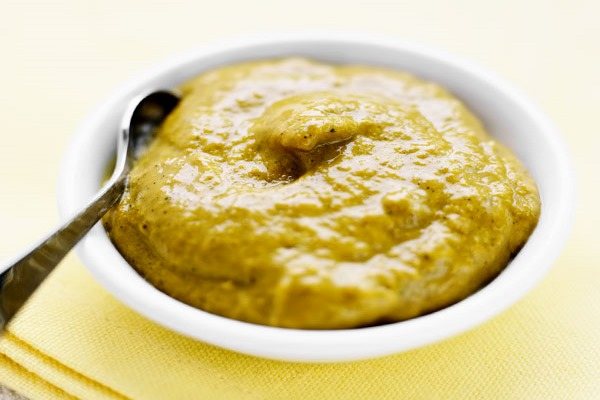
Choosing high-quality mustard or preparing the seasoning yourself, observing storage times, as well as rationing the product eaten will help reduce the likelihood of a negative reaction to the seasoning.
Impact on the child and lactation
Mustard powder, which contains essential oils, is a serious irritant. In dry form they are completely neutral, but after getting wet in warm water the oils are activated. And after applying mustard plaster to the skin, they begin to actively interact with it. This leads to the fact that the vessels dilate, blood flow increases and medicinal substances are distributed throughout the body.
During lactation, blood with mustard oils reaches the mammary glands
. As a result, the produced milk also contains a small concentration of this substance. For a child, its use is considered extremely undesirable, because can trigger various allergic reactions and cause increased anxiety.
It is precisely because of the negative impact on the child’s body that the use of mustard plasters is contraindicated both during pregnancy and lactation.
Why is mustard harmful for nursing and infants?
In addition to useful elements, mustard also contains vinegar with a certain percentage of acid. Acetic acid causes digestive irritation and can lead to serious intestinal and stomach problems in an infant. In addition, the product often contains pepper, cloves and other spices, which cause severe allergies in children.
Store-bought seasonings contain a large amount of dyes and preservatives, flavorings and other chemicals that are dangerous for both the baby and the mother. Food additives negatively affect digestion and often cause allergic symptoms on the skin. Processing and removing such substances from the body places a heavy burden on the child’s kidneys and liver. In addition, chemical food additives negatively affect the production of breast milk and impair lactation.
Thus, mustard has the following negative effects:
- Irritates and burns the digestive organs;
- Causes allergies in infants;
- Leads to ulcers and other diseases of the stomach and intestines;
- Disturbs the functioning of the kidneys and liver;
- Worsens the course of lactation.
Doctors do not recommend that nursing mothers consume mustard during the first six months, and only if the baby has not previously exhibited allergic reactions or digestive problems. If you have a negative reaction, it is better not to use this seasoning until the end of breastfeeding.
If you decide to introduce mustard into your diet while breastfeeding, first try a small dose and observe your baby’s reaction for two days. Food allergies appear within 24 hours. If the baby reacts normally, a nursing mother can sometimes eat mustard in reasonable quantities.
Instead of mustard, sour cream, vegetable oil and lemon juice are suitable as a dressing for dishes during breastfeeding if the baby is not allergic to lemon. Such products are safe for children, enhance the taste of dishes and diversify the menu during lactation.
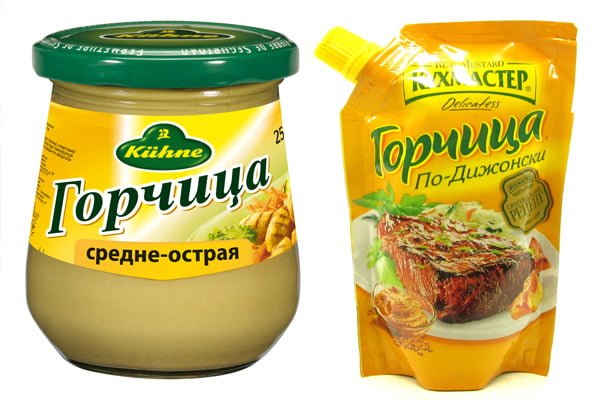
From when can you eat mustard?
The components of mustard pass into the mother's milk, and with it into the baby. If mustard helps a woman’s body, it is more likely to harm a child’s – which is why it is not recommended to use this spice for at least the first 5-6 months after giving birth, until the baby’s one meal is replaced with complementary foods. In this case, a nursing mother can eat mustard after the feeding preceding complementary feeding - by the time of the next feeding, a very small part of the mustard components will remain in the milk.
If the child is on mixed feeding, it is even easier - the algorithm is the same, only you can enjoy the mustard even earlier, the main thing is that the child does not drink breast milk in the next 5-6 hours.
And, of course, you should limit yourself to a small amount of spice - purely to set your teeth on edge.
Principles of using mustard for hepatitis B
Adherents of the theory of intuitive nutrition argue that if a woman wants any foods, they should definitely be included in the diet - the body thus subconsciously hints that it lacks certain microelements. According to this theory, a nursing mother may lack the following beneficial elements contained in mustard:
- vitamins A, D, E, PP, B vitamins;
- trace elements magnesium, potassium, sodium, zinc;
- essential oils containing omega-3 and omega-6;
- protein (in mustard oil its share is approximately 25%).
But everything is good in moderation. If you nevertheless decide to introduce mustard while the baby is actively breastfed, after consuming the spice it is necessary to monitor the baby’s reaction and his condition - if something changes for the worse during the day (anxiety appears, poor sleep, rash), you should use mustard postpone until the end of the GW.
Principles of use for hepatitis B
Nursing mothers are not recommended to place mustard plasters directly on the mammary glands
, as well as the area adjacent to them. After all, the closer they are to the breast, the more mustard oils can get into the milk, and with it into the baby’s body.
In addition, one should take into account various contraindications that apply to all patients without exception.
Namely, mustard plasters cannot be installed:
- around the heart area;
- along the spinal column;
- on the shoulder blades;
- on the chest.
Where should I put it?
To achieve maximum therapeutic effect, mustard applications should be applied to certain areas of the body. For ARVI (without high fever), mustard plasters can be applied to:
- upper back (for bronchitis);
- on the chest or on the side of it (for pneumonia and bronchitis);
- between the shoulder blades;
- on the feet and calves.
Attention!
These procedures are an excellent remedy for coughs, runny nose and sore throat. Their main therapeutic effect is the dilution of sputum, which promotes its better discharge.
Sequence of procedure
The correct procedure for using mustard plasters should be followed by every patient, however, it is most relevant for women who are breastfeeding.
For an ordinary person, the time for applying mustard plaster can vary from 5 to 15 minutes, without much harm to the body. However, when breastfeeding, you should try not to overexpose mustard plasters.
and strictly follow the required doctor’s instructions.
To eat or not to eat mustard while breastfeeding
There is no consensus on whether mustard can be consumed while breastfeeding or not. It is known that during lactation, a woman begins to feel better about her body and its natural needs.
Proponents of intuitive nutrition believe that if a woman persistently wants a certain product, then she should listen to her body, even if traditional medicine is wary, or even completely negative, about this or that product.
It is quite possible that the nursing mother lacks some specific substances, components, vitamins or microelements necessary for health, and mustard contains them.
The determining factor in the benefits and possible negative consequences for the body of the mother and baby is precisely the volume and quantity of the product consumed.
If you regularly listen to your body and give it exactly what it needs, the likelihood of overdoing it on a particular product will be significantly reduced.
It’s better to eat a chicken breast with a spoonful of quality French mustard than a jar of jam with an organic sugar substitute, which you don’t need right now, but it’s on the list of allowed foods!
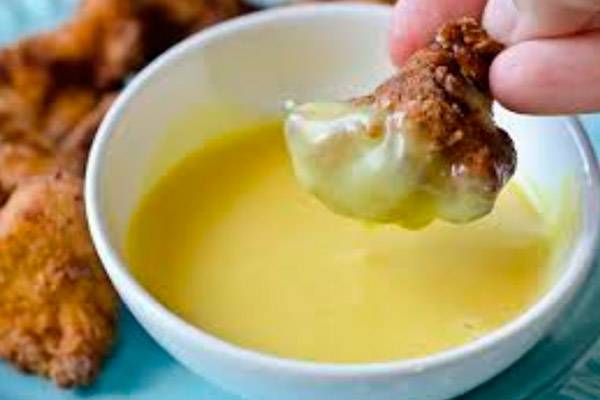
Alternative remedies
There are situations when the use of mustard applications is strictly contraindicated for a woman who is breastfeeding. In this case, in order to quickly overcome the disease, you can use alternative, more harmless, methods.
In the presence of infectious diseases of the upper respiratory tract, it is recommended to use medications based on natural ingredients. These are:
- liquorice root;
- plantain extracts;
- thyme and the like.
Decoctions infused with these plants activate the body's defenses, and at the same time do not harm the baby who is breastfeeding.
Most of the above natural remedies can also be used to prepare compresses. They are also applied to the sternum or back, but at the same time have virtually no irritating effect on the skin.
- warm milk;
- butter.
Important!
The only limitation is individual intolerance to these products.
Alternative to mustard plasters
If for some reason a nursing woman is unable to use mustard applications to treat colds, then she can use alternative therapy methods.
For the treatment of infectious and inflammatory diseases of the respiratory tract, medicines based on extracts of plantain, thyme, licorice root and thyme from anise grains are used. Decoctions and infusions from these plants have a mucolytic, anti-inflammatory and expectorant effect.
In addition, decoctions of these herbal components are used to apply compresses to the chest and back. Such local treatment is not accompanied by an irritating effect, which indicates a milder effect on the body. A mixture of warm milk, bee honey and butter is used as an expectorant for bronchitis. This remedy is not prohibited for nursing women, provided they are not allergic to bee products.
As an alternative to pharmaceutical cough syrups. This root plant contains active components that stimulate the motor activity of the ciliated epithelium of the bronchi, which entails the removal of excess mucus. It is important to remember that the use of each of the remedies mentioned must be agreed with your doctor.
